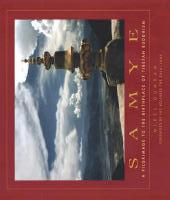 Samye
Samye

Nestled deep in the "Land of Snow" stands Samye, the monastery where Buddhism first took root in Tibet. Join acclaimed photographer Mikel Dunham on a journey to this rarely seen and sacred place. Preceded by a moving and remarkable foreword by the Dalai Lama, Samye: A Pilgrimage to the Birthplace of Tibetan Buddhism, is a collection of nearly 200 original color photographs and compelling text that transports readers to this significant site in Tibetan culture.
That Samye still exists is nothing short of a miracle. Founded in the year 770 under the guidance of the great Indian Tantric master, Padmasambhava, it has withstood several major fires; 1,200 years of the harsh Tibetan winter; and the devastating invasion of the Red Army. The invasion was almost the monastery's undoing as soldiers destroyed its magnificent golden roof, desecrated its frescoes, burnt irreplaceable ancient texts, and expelled or killed the monks who called it "home."
Historically, Samye was the first monastery in Tibet and, as such, saw the ordination of the first Tibetan monks. It also became a translation school unparalleled in Asian history. Architecturally, Samye is built in the form of a three-dimensional mandala-a universal map pointing the Buddhist pilgrim's way to enlightenment. Spiritually, Samye remains an invaluable treasure in the minds and hearts of all Tibetans. In 2000, Mikel Dunham was given the unique invitation of full access to Samye to record its treasures, many of which had never been photographed.
As a trained thangka master in the Tibetan manner of painting, photographer Mikel Dunham brings an insightful perspective to the readers as he explains Samye's remarkable history and documents its current restoration effort. As you turn the pages of this book filled with accounts of the early years of Tibetan Buddhism and interlaced with photographs of the Tibetans who still populate this cherished land, you are invited to explore the vast potential of your own spiritual path-wherever that may lead you.
|
|
Samye è un'emozione. Non tanto per i templi restaurati, ma per la "Samye" interiore, quella della descrizione di Tucci. Venne poi la apertura del Tibet. Ricordo la prima descrizione di come erano i templi. Confrontavo la relazione dell'amica Marisa Da Re che vi giunse nell'85 con uno dei primi gruppi di Avventure nel Mondo. I templi trasformati in silos. Samye non era raggiungibile nel luglio dell'86 quando visitai il Tibet con il mio gruppo, né lo raggiunsi nei viaggi successivi. Finalmente nel 1998 al quarto viaggio attraversai lo Tsang-po. Ma non vedevo la Samye di ora, né quella di Tucci o di Marisa. Vedevo la Samye di Ippolito Desideri, quella che lui raggiunse in fuga da Lhasa durante i tumulti che vi scoppiarono durante la sua permanenza. E tutt'oggi mi rimane il desiderio di percorrere quel tragitto attraverso i monti partendo dalla ricostruita Ganden, l'altra cittadella monastica che subì lo scempio della distruzione cinese. |